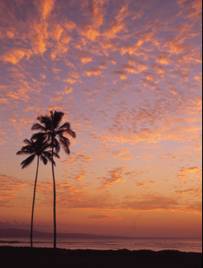
Weather in the Hawaiian Islands is dominated by the North Pacific High and associated northeast Trade winds. While typically moderate to mild, on occasion impacts of Strong Trade Winds, Trade Wind Showers, and Trade Wind Swell are felt. Trade wind conditions dominate between April and October. Their impacts are greatest in the mountains and along east-facing, windward coasts.
Tropical Cyclones (Hurricanes) and tropical storms most commonly occur between the months of June and October. These infrequent, but extreme storms generate strong winds, heavy rains, and high seas. Typically they pass to the south and west of the Hawaiian Islands. On rare occasions there is a direct hit (e.g., Hurricane Iniki in 1992).
Occurring most frequently in January, but common throughout the months of October through May, Local "Kona" Storms ("sub-tropical" cyclones) can generate widespread heavy rains accompanied by strong winds that last for days, as well as intense local showers affecting a small area for several hours. These storms that occasionally enter the Hawaiian area are cut-off lows in the upper level subtropical Westerlies that usually occur to the north of Hawaii, and are associated with surface lows. The term Kona storms is now increasingly applied to any widespread rainstorm accompanied by winds from a direction other than that of the Trade winds. With winds typically arriving from the southwest, the impacts of these storms are greatest along leeward coasts.
Frontal Systems usually occur during the period from December through March. They sweep across the islands bringing with them locally heavy showers and gusty winds. Typically these rains are spotty, with several inches falling in some areas and only fractions of an inch in others. Winds are gusty, with wind directions mainly from the north and northwest. Occasionally a cold front storm will produce winds that blow down trees or rip the roofs from houses. Extreme weather from such storms can have the longest duration of any major storm type because the systems are large and move or weaken slowly.
Upper Level Lows can occur any time of the year, although they too usually occur during the period from December through March. The presence of an upper-level trough or low to the northwest of the islands helps produce unstable conditions with heavy rainfall, The weather which accompanies these systems - towering cumulus clouds, thunderstorms, intense and widespread rain - often resembles that of a Kona storm. However, upper level lows usually are not as persistent and are not always marked by the strong, low-level southerly winds that generally accompany Kona storms.
In addition to high seas caused by tropical cyclones and local storms, the affects of distant storms can also be felt in the islands. During the winter Extra-tropical Storm Surf can impact north-facing shores and, during the summer, south-facing shores.
Extreme Tides, which tend to occur around the winter and summer solstices (December and June), are also relevant with respect to high seas. Extreme tides have the greatest impact when they occur in conjunction with other phenomena such as storm waves, storm surge, or an "anticyclonic" eddy which temporarily raises local sea level.
For a more detailed discussion of the Extremes Climatology of the central North Pacific go to:
- Strong Trade Winds, Trade Wind Showers, and Trade Wind Swell
- Tropical Cyclones (Hurricanes) and Tropical Storms
- Local "Kona" Storms ("Sub-Tropical" Cyclones)
- Frontal Systems
- Upper Level Lows
- Extra-Tropical Storm Surf
- Extreme Tides
See the glossary for more information about some of the key atmospheric and oceanographic features that affect extreme winds, rainfall, waves and water levels in the Pacific.
See also the WRCC Climate of Hawaii.






